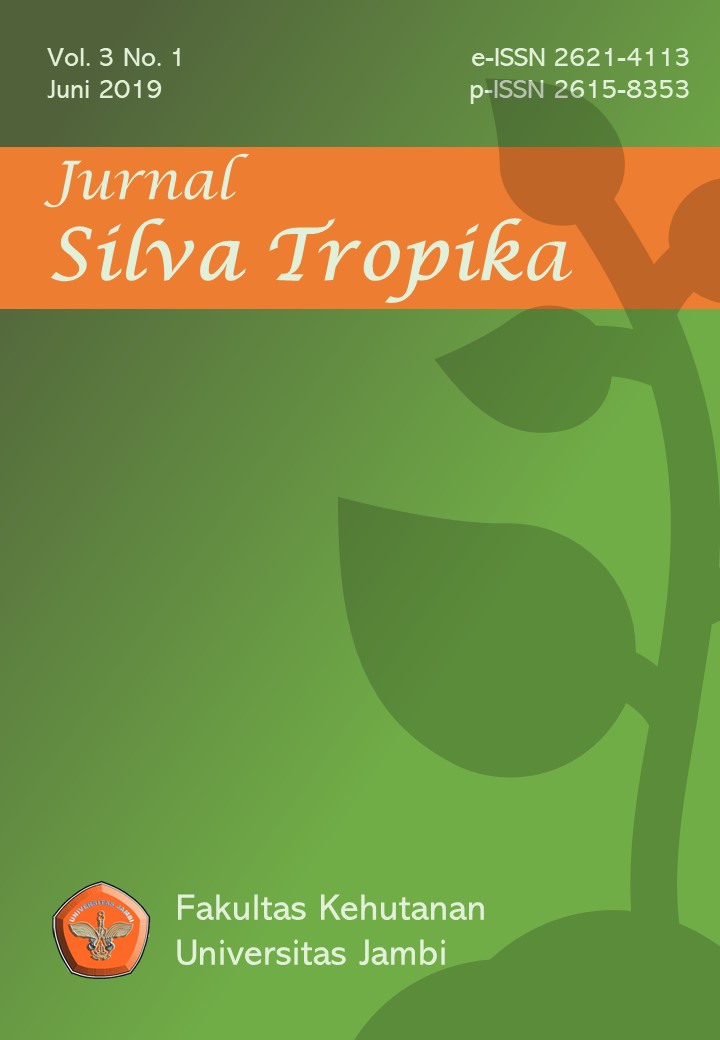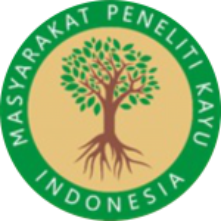Characteristics of Eucalyptus Essential Oil from 3 Clones Eucalyptus pellita F. Muell tree
DOI:
https://doi.org/10.22437/jsilvtrop.v3i1.6403Keywords:
Keywords: Characteristics, Eucalyptus essential oil, Eucalyptus pellita F. Muell, Clone treeAbstract
Essential oil is a non-timber forest product commodity that has a high selling value. PT. Wirakarya Sakti (PT. WKS) is one of the owners of an industrial plantation forest (HTI) that plants Eucalyptus pellita F. Muell. The utilization of this tree is only focused on wood for pulp production, so it produces leaf and bark waste. The E. pellita leaves are very potential to produce essential oils that have high selling value. However, the characteristics of essential oil from this E. pellita clones are still unknown. Therefore, it is necessary to analyze the quality of eucalyptus essential oils from these clones. The leaves of E. pellita from clone tree 77, 361, and 364 in PT. WKS was harvested and distilled using the water and steam distillation method to produce the essential oil. After that, the yield of essential, physical and chemical characteristics was analyzed following the Indonesian national standards (SNI 06-3954-2006). The results showed the yield percentage of eucalyptus oil from 3 clone trees are 0.080–0.130%. The results of physical and chemical characteristics of essential oil showed: (1) eucalyptus oil color is yellowish-green, (2) it has a distinctive smell of eucalyptus oil, (3) the specific gravity between 0.900–0.907, (4) 80% solubility in ethanol shows 1:10 turbid, (5) cineole percentage between 39.65–41.13%, and (6) refractive index between 1.462–1.463. The data analysis showed that clone 77 has a higher quality compared to the others.
Downloads
References
Astiani DP, Jayuska A, Arrenez S. 2014. Uji aktivitas antibakteri minyak Eucalyptus pellita terhadap bakteri Escherichia coli dan Staphylococcus aureus. JKK 3(3):49–53
Buchbauer G, Jirovetz L, Jager W, Dietrich H, Plank C. 1991. Aromatherapy: Evidence for sedative effects of essential oil of lavender After Inhalation. Journal of Biosciences 46(11–12):1067–1072
Damanik M. 2009. Kajian Minyak Atsiri pada Ekaliptus (Eucalyptus urophylla) Umur 4 Tahun di PT. Toba Pulp Lestari. Skripsi. Medan: Universitas Sumatera Utara.
Guenther E. 1974. Minyak Atsiri. Volume ke-1. Ketaren S, penerjemah: Jakarta: Universitas Indonesia Press. Terjemahan dari: Essential Oil.
Guenther E. 1987. Minyak Atsiri. Volume ke-1. Ketaren S, penerjemah: Jakarta: Universitas Indonesia Press. Terjemahan dari: Essential Oil.
Guenther E. 2006. Minyak Atsiri. Jilid IV B. Diterjemahkan oleh S. Ketaren. Jakarta: Universitas Indonesia Press.
Iskandar U, Ngadiono, Nugraha A. 2003. Hutan Tanaman Industri di Persimpangan Jalan. Jakarta: Arivco Press
Ketaren S. 1985. Pengantar Teknologi Minyak Atsiri. Balai Pustaka. Jakarta.
Khabibi J. 2011. Rendemen dan mutu minyak kayu putih dari penyimpanan daun dan variasi volume air penyulingan [Skripsi]. Bogor: Fakultas Kehutanan, Institut Pertanian Bogor
Koensoemardiyah S. 2010. A to Z Minyak Atsiri untuk Industri Makanan, Kosmetik dan Aromaterapi. Yogyakarta: CV Andi Offset
Rasyid A, Rini P, Tommy L. 2016. Uji Sifat Fisiko-Kimia dan Efektivitas Minyak Eucalyptus brassiana, Eucalyptus pellita, serta Persilangan Eucalyptus brassiana dan Eucalyptus pellita sebagai Anti Rayap Kayu Kering (Cryptotermes cynocepalus Light.) [Skripsi]. Yogyakarta: Fakultas Kehutanan, Universitas Gadjah Mada
Ratnaningsih AT, Insusanty E, Azwin. 2018. Rendemen dan kualitas minyak atsiri Eucalyptus pellita pada berbagai waktu penyimpanan bahan baku. Wahana Forestra: Jurnal Kehutanan 13(2):1–9
Sudarti, Warasti S. 1979. Pengaruh penyimpanan daun kayu putih (Melaleuca leucadendron Linn.) terhadap hasil dan kualitas minyak kayu putih [tugas akhir]. Yogyakarta: Fakultas Farmasi, Universitas Gadjah Mada.
Sumadiwangsa S, Sutarna MS, Siti H. 1973. Pedoman Pengujian Kualitas Minyak kayu putih. Lembaga Penelitian Hasil Hutan Direktorat Jenderal Kehutanan Departemen Pertanian.
Sumangat D, Ma’mun. 2003. Pengaruh Ukuran dan Susunan Bahan Baku serta Lama Penyulingan Terhadap Rendemen dan Mutu Minyak Kayumanis Srilangka (Cinnamomun Zeylanicum). Buletin TRO XIV(1)
Supriatin, Ketaren S, Ngudiwaluyol S, Friyadjl A. 2004. Isolasi Miristisin dari Minyak Pala (Myristicafragrans) dengan Metode Penyulingan Uap. Jurnal Teknologi Industri Pertanian 17(1): 23–28.
Widiyanto A, Siarudin M. 2014. Sifat fisikokimia minyak kayu putih jenis Asteromyrtus brasii. Jurnal Penelitian Hasil Hutan 32(4):243–252
Zulnely, Gusmailina, Kusmiati E. 2015. Prospek Eucalyptus citriodora sebagai minyak atsiri potensial. Pros Sem Nas Masy Biodiv Indon 1(1):120–126
Additional Files
Published
Versions
- 2019-06-30 (1)
- 2019-06-30 (1)















